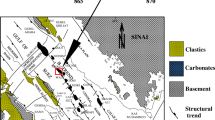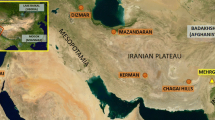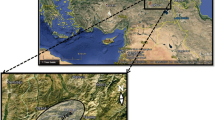Abstract
The current survey aimed to relocate the so-called granitic ‘stela’ inscribed for King Pepi I. The monument was originally discovered in 1897–1898 by British Egyptologists excavating on an ancient mound located in the floodplain at the archaeological site of Hierakonpolis (modern Kom el-Ahmar) in the Aswan Governorate of Egypt. The original excavators were unable to remove it owing to its great weight and the monument was therefore left at the site. It remained partly exposed until 1989, when it was reburied to provide some protection from seasonal fluctuations in the water table. The exact location of the ‘stela’ was then lost, as the site is situated in the centre of the modern village of Kom el-Gemuwia and is covered with halfa grass and other debris. As part of a new project to conserve and record this historic monument and other stone relics on this water-logged site by the Hierakonpolis Expedition of the Ashmolean Museum, University of Oxford, UK, a geophysical approach was used to establish their current locations. A detailed gamma-ray spectrometry survey was conducted across the area suggested by the archeologists. The measurements were analyzed and plotted in the form of maps, which were helpful in selecting certain locations for examination. The results of limited field excavations confirmed that the localized high-thorium-concentration anomalies were mainly related to the presence of the buried granite block. These results suggest that this method could be useful in the detection of granitic monuments at similar sites.







Similar content being viewed by others
References
Adams, B. (1995). Ancient Nekhen: Garstang in the city of Hierakonpolis. Whitstable: SIA.
Attia, T. E., & Shendi, E. H. (2013). Uranium migration history in the igneous and metamorphic rocks of Solaf-Umm Takha area, based on multi-variate statistical analysis and favorability indices, central south Sinai, Egypt. IOSR Journal of Applied Geology and Geophysics, 2013, 2321-0990.
Dickson, B., & Scott, K. (1997). Interpretation of aerial gamma-ray surveys-adding the geochemical factors. AGSO Journal of Australian Geology and Geophysics, 17, 187–200.
El-Shishtawy, A., Atwia, M., El-Gohary, A., & Parizek, R. (2013). Impact of soil and groundwater corrosion on the Hierakonpolis Temple Town archaeological site, Wadi Abu Sufian, Idfu, Egypt. Environmental Monitoring and Assessment, 185(6), 4491–4511.
Erdi-Krausz, G., Matolin, M., Minty, B., Nicolet, J., Reford, W., & Schetselaar, E. (2003). Guidelines for radioelement mapping using gamma ray spectrometry data: Also as open access e-book. Vienna: International Atomic Energy Agency (IAEA).
Fairservis, W. (1981). The Hierakonpolis project. Season January to May 1981. Occasional papers in anthropology III. Poughkeepsie: Vassar College.
Friedman, R. (2011). Hierakonpolis. In E. Teeter (Ed.) Before the pyramids. The origins of Egyptian civilization, vol. 33 (pp. 33–44). Chicago: Oriental Institute Publications. http://oi.uchicago.edu/pdf/oimp33.pdf.
Friedman, R. (2013). Hierakonpolis. The encyclopedia of ancient history. Oxford: Wiley.
Kaiser, M., Aziz, A., & Ghieth, B. (2014). Environmental hazards and distribution of radioactive black sand along the Rosetta coastal zone in Egypt using airborne spectrometric and remote sensing data. Journal of Environmental Radioactivity, 137, 71–78.
Klepper, M. R., & Wyant, D. G. (1957). Notes on the geology of uranium. New York: US Government Printing Office.
Manly, B. F., & Alberto, J. A. N. (2016). Multivariate statistical methods: A primer. New York: Chapman and Hall.
McKelvey, V. E., & Nelson, J. M. (1950). Characteristics of marine uranium-bearing sedimentary rocks. Economic Geology, 45(1), 35–53.
McNamara, L. (2008). The revetted mound at Hierakonpolis and early kingship: A re-interpretation. In B. Midant-Reynes, & Y. Tristant (Eds.), Egypt at its origins 2. Proceedings of the International Conference “Origin of the state, Predynastic and Early Dynastic Egypt”, Toulouse (France), 5th–8th September 2005: Leuven, pp. 901–936.
Menager, M., Heath, M., Ivanovich, M., Montjotin, C., Barillon, C., Camp, J., et al. (1993). Migration of uranium from uranium-mineralised fractures into the rock matrix in granite: Implications for radionuclide transport around a radioactive waste repository. Radiochimica Acta, 66(67), 47–83.
Moussa, M. (2001). Gamma-ray spectrometry: A new tool for exploring archaeological sites; a case study from East Sinai, Egypt. Journal of Applied Geophysics, 48(3), 137–142.
Mussett, A. E., & Khan, M. A. (2000). Looking into the earth: An introduction to geological geophysics. Cambridge: Cambridge University Press.
Quibell, J. E., & Green, F. W. (1902). Hierakonpolis: Part II. London: Quaritch.
Raychaudhuri, S., Stuart, J. M., & Altman, R. B. (1999). Principal components analysis to summarize microarray experiments: Application to sporulation time series. In Biocomputing 2000 (pp. 455–466). Singapore: World Scientific.
Reynolds, J. M. (2011). An introduction to applied and environmental geophysics. Oxford: Wiley.
Shives, R. B., Charbonneau, B., & Ford, K. L. (2000). The detection of potassic alteration by gamma-ray spectrometry—recognition of alteration related to mineralization detecting ore using GRS and K alteration. Geophysics, 65(6), 2001–2011.
Stearns, A. D. (2006). Effects of large irrigation projects on regional ground water chemistry near Hierakonpolis, Egypt. PhD diss., Pennsylvania State University.
Tzortzis, M., Tsertos, H., Christofides, S., & Christodoulides, G. (2003). Gamma radiation measurements and dose rates in commercially-used natural tiling rocks (granites). Journal of Environmental Radioactivity, 70(3), 223–235.
Wemegah, D. D., Preko, K., Noye, R. M., Boadi, B., Menyeh, A., Danuor, S. K., et al. (2015). Geophysical interpretation of possible gold mineralization zones in Kyerano, south-western Ghana using aeromagnetic and radiometric datasets. Journal of Geoscience and Environment Protection, 3(04), 67.
Acknowledgements
We are grateful to the Minister of State for Antiquities, Dr Khaled el-Anany, and the members of the Permanent Committee of the Supreme Council for Antiquities for permission to undertake work at Hierakonpolis. Thanks are also extended to the PSU Center of Environmental Studies and Consultancies. We are very grateful to Mr. Mahmoud Ismail for his valuable help and effort during the field surveys. The assistance of the Edfu Inspectorate of Antiquities is also gratefully acknowledged.
Author information
Authors and Affiliations
Corresponding author
Rights and permissions
About this article
Cite this article
Aziz, A., Attia, T., McNamara, L. et al. Application of Gamma-ray Spectrometry in Discovering the Granitic Monument of King Pepi I: A Case Study from Hierakonpolis, Aswan, Egypt. Pure Appl. Geophys. 176, 1639–1647 (2019). https://doi.org/10.1007/s00024-018-2036-1
Received:
Revised:
Accepted:
Published:
Issue Date:
DOI: https://doi.org/10.1007/s00024-018-2036-1





